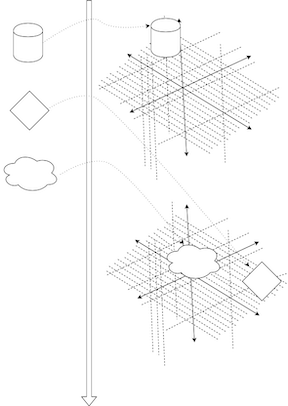The Language of God (3DL)
Summary
“The Language of God” - What a "God's-eye" view (or "Eagle's-eye" view, if you prefer) would look like. Perhaps something like (but still far inferior from) a way in which we would communicate from such a vantage-point.
Uniting some thoughts expressed previously as part of the "descendent knowledge domains returning to revitalize philosophy" methodology.
Use Cases
- Metaphysical Linguism - The doctrine that there are only language systems. Language systems do not frame metaphysical debates, rather metaphysics (the study of reality) is ultimately the study of language systems. I will discuss further what this conception of a language system is so that the immediate incredulity this thesis likely engenders, falls away.
- Simple hieroglyphic-like writing language.
- Clarifying some ways of thinking about metaphysics in philosophy.
- Rechender Raum.
Survey
These are the building blocks of 3DL:
- Predicates or Types: a pre-defined list of Euclidean geometric structures.
- Spaces: 3-Dimensional Euclidean Spaces here.
- Instances: a "copy" or instantiation of a Predicate located in a Space.
- Propositions: temporal ordering of concatenated Spaces - a 4-Dimensional world line.
A Predicate, a Type, is a 3-Dimensional entity which is instanced by being placed into a 3-Dimensional Space.
For those familiar with philosophical metaphysics or those familiar with software tools like AutoCAD (where a GUI with pattern Types are “dragged onto” a canvas to create a specific “copy”).
This should come as no surprise since such visualization tools and their attendant programming languages are meta-languages for a host of language families.
All of set theory can be expressed in English and Microsoft Word, all of category theory can be expressed in Draw.io, etc.
This is the very definition of a meta-language - a top-level language within which more-specific languages can be built (whether combinations of pixels, fragments of a language, new math theories, etc.). It's a mathematical property of these tools that contributes to their wide-spread use and flexibility - particularly for creatives.

In this language, people communicate by concatenating sequences of Spaces forming Propositions.
Each 3-Dimensional Space is a set of 2-Dimensional pointless topologies. Each 2-Dimensional space is written using Connection Theory.
Tense is captured by natural orderings (temporal sequences) of each 3-Dimensional Space.
Formalization
Formally, a quick sketch of the lexicon of 3DL:
- Types: a geometric, mathematical, object defined independently of the Spaces and Temporal Orderings. Free-standing, and separated from the assertions made in 3DL. They can be expressed in their own sub-fragment, meta-language, etc.
- Instances: are Type copies positioned or situated in a Space.
- Spaces: are concatenated into sequences which form natural Temporal Orderings.
- A Frame of Reference is a set of Propositions or Temporal Orderings.
The grammar of 3DL: Combinations of Types as Instances in Spaces.
The semantics of 3DL: The truth of a Proposition
Pis given by its invariance with or isomorphism to other PropositionsR,Q,N, ...
- Non-Eternalist Logic
- Non-Eternalist Logic #2
- Non-Eternalist Logic #3
- Transactional Logic
- Logical Module
- Dimensional and Hyper-Dimensional Logics
- Dimensional and Hyper-Dimensional Logics #2
- Language of God
- Propositional Stability and Cohen Forcing
post: 11/14/2018
update: 1/21/2020
update: 1/23/2020
update: 4/20/2020